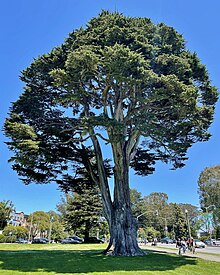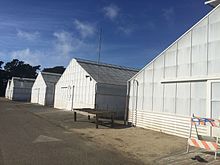Golden Gate Park
Golden Gate Park was carved out of unpromising sand and shore dunes that were known as the Outside Lands, in an unincorporated area west of San Francisco's then-current borders.
In 1882 Governor George C. Perkins appointed Frank M. Pixley, founder and editor of The Argonaut, to the board of commissioners of San Francisco's Golden Gate Park.
Despite obstacles such as heavy tides and winds that carried sand inland towards the park, McLaren was able to build an esplanade by stacking thousands of tree boughs over the course of 20 years.
Thus, the duties of the department were transferred to the Works Progress Administration (WPA), a government program designed to provide employment and community improvements during the economic woes of the 1930s.
[13] Famous artists such as Gary Snyder and Allen Ginsberg were in attendance, as calls for alternative lifestyles and expanded consciousness reflected the countercultural attitudes of the period.
[13] The eastern end of the Park was the epicenter of the Summer of Love, with an estimated 100,000 youth visiting the Haight-Ashbury district, where they embraced communal living and counter-establishment values.
[15] Hippie Hill was a central meeting place, and renowned artists like Janis Joplin, the Grateful Dead, Jefferson Airplane, and George Harrison performed free concerts there during the Summer of Love.
Her stop included a dinner at the De Young Museum, attended by then-President Ronald Reagan, Willie Mays, George Lucas, Joe DiMaggio, and Steve Jobs.
[23] Notable Outside Lands headliners have included Radiohead, Paul McCartney, Kendrick Lamar, Elton John, The Weeknd, Billie Eilish, Tyler, the Creator, and SZA.
[25] In 2022, the Board of Supervisors voted 7-4 to keep the eastern section of John F. Kennedy Drive permanently car-free,[26] a decision affirmed later that year by voters who defeated a ballot initiative which sought to revert the change.
"[30] Since the opening of the De Young in 1921, its galleries have mostly changed, but some of the art originally featured during the fair and in the early twentieth century still exists in the museum today.
The present building encompasses 37,000 square meters[32] and includes exhibits of natural history, aquatic life, astronomy, gems and minerals, and earthquakes.
[32] Due to its eco-friendly materials and natural sources of energy, the California Academy of Sciences has been named the country's only LEED-platinum certified museum, granted by the U.S. Green Building Council.
[45] Built of traditional wood and glass panes, the Conservatory stands at 12,000 square feet[46] and houses 1,700 species of tropical, rare and aquatic plants.
A bronze statue of Don Quixote and his companion, Sancho Panza kneeling to honor their creator, Cervantes, combines historical and fictitious characters.
[9] During the George Floyd protests, on June 19, 2020, demonstrators toppled or otherwise vandalized the statues of Catholic missionary Junípero Serra, Francis Scott Key (author of the lyrics to The Star-Spangled Banner), Ulysses S. Grant, Cervantes, Don Quixote and Sancho Panza.
One can usually find both 'sail driven,' self-guided Yachts and electric or gas/nitro powered radio-controlled model boats of many types and designs plying the lake's waters most times of year.
[93] At the time, the animal's population in North America had dwindled to an all-time low, and San Francisco made a successful effort to breed them in captivity.
At its peak and through a successful captive breeding program, more than 100 calves were produced at Golden Gate Park, helping preserve the iconic bison population numbers in North America, which has been critical to the culture and livelihood of Native Americans.
[citation needed] Nestled in the trees between the Conservatory of Flowers and Haight Street, Hippie Hill displays a lifestyle unique to San Francisco.
East of the Golden Gate Park tennis courts, the green space known as Hippie Hill is a gentle sloping lawn just off of Kezar Drive and overlooking Robin Williams Meadow,[95] with Eucalyptus and Oak on either side.
During this era, people gathered in the area to connect with one another through many activities, including the playing of music, consumption of LSD and marijuana, and expression of hippie ideals.
[98] As supervisor London Breed stated, "smoking anything in any city park is illegal, but San Francisco has a tradition of turning a blind eye to infractions for official or unofficial events.
Under the Significant Natural Resource Areas Management Plan, the city will remove many invasive species and replace them with native plants.
Monterey pines are also prevalent today and can found in the Strybing Arboretum, the Japanese Tea Garden, and in the western portions of the park around the Buffalo Paddock.
[125] Due to its serene environment of redwoods, maples, ferns, benches, logs, and boulders, this memorial remains a place where people go to grieve, hope, heal, and remember.
The cast was made and given to the garden by George Bullock in 1918 and has remained behind locked doors since around 1950 to prevent people from cutting off pieces of the bronze statue to melt down.
Historically, many major music festivals took place in the park, including the Human Be-In, which featured bands like the Grateful Dead and Jefferson Airplane.
[164] The camps have been described by journalists as full of garbage, broken glass, hypodermic needles, and human excrement, and the people in them are described as suffering from serious addictions and often behaving aggressively with police and park gardeners.
[168] In the 1990s, then-Mayor Willie Brown sought unsuccessfully to borrow the Oakland Police Department's helicopters in order to find homeless people's camps.



























